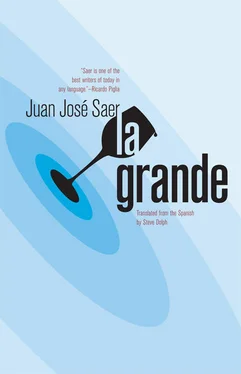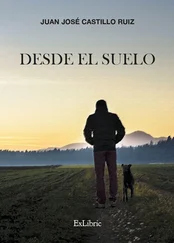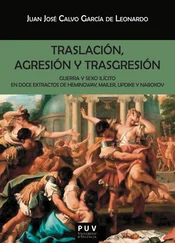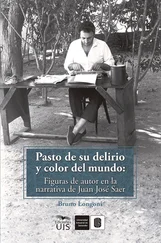Beyond the bar, two or three sailboats — sails furled and decks empty — are anchored, several meters from shore, near the beach on the Piedras Blancas side of the river. Breaking up the sandy expanse are several trees, an acacia, two young eucalyptus, and two or three others whose species Soldi can’t identify at that distance. A group of single-color umbrellas, reds and yellows, are scattered around the empty space, separated from the two-colored ones, divided into ten alternating segments, also red and yellow: the brightly colored canopies project black circles onto the sand without the two circles coinciding completely, the position of the sun causing the black circle to be displaced slightly with relation to the red or yellow circle that projects it. Their feet scratching lightly against the sand, Gabriela and Soldi move away from the “port” toward what strictly speaking would be called the beach. When she senses their presence, the woman in the yellow T-shirt stops playing with the child, watches them a moment, and then, taking her own reduced image by the hand, moves away from the water and starts walking slowly toward the exit down a path that opens between the trees. Gabriela, slightly mortified by their departure, nevertheless acts as though she hadn’t seen them. Where the white rocks end the ground elevates to a high lifeguard tower, a white wooden structure consisting of a fixed ladder topped with a seat, and which because of its height dominates the whole beach, whose perimeter is marked by a semicircular chain of red buoys, one end of which is attached to the shore at the edge of the white rocks and the other to some vague spot beyond the shore. Not only are there no bathers, there are no lifeguards; the few people there are sitting at tables around the bar, under the shade of the umbrellas. It’s quiet enough that as they approach the damp edge of the shore they’re able to perceive the almost inaudible murmur of the water.
In the windless afternoon the almost transparent surface is furrowed by long, delicate wrinkles, parallel to the beach, that appear motionless and whose circulation is only visible in the final curl coming and going along the surface, betraying, inconspicuously, its movement.
— It’s not really noticeable right now, but there’s a rising tide, Soldi says, and he and Gabriela, simultaneously though in opposite directions, observe the river around them. The wide channel, two hundred meters across, framed at one end by the seawall at the waterfront, and to the north, on the Guadalupe side, by a circular expanse a few kilometers in diameter that everyone, even the cartographers, refers to as the lagoon because of its shape, though everyone knows that actually a branch of another branch of another branch (called rivers, streams, tributaries), and a few others that form the Paraná on its way to the delta, spill together on a northward bend to form the lagoon, then turning south again form the city’s port, eventually meeting another channel that, with many others, will return the dark current to the breast of the father that at some indefinite point, or everywhere at once starting at the first thread of source water upriver, engendered it. Soldi says that the beach seems so new because the floods, two in recent years, have submerged it. It had been rebuilt for the third time, Soldi says stoically, at the start of the season that had just finished. The ’82 flood washed away the Guadalupe beach and several of the houses that had been fearfully built up around it, and the water level never went back down at that spot in the river. And with him , Soldi says, nodding to the south, the one in ’82 shook him up , and the one the next year finished the job. Gabriela surveys the section of the suspension bridge that still stands a few blocks away, half of it more or less, the part closest to the city; halfway down, the structure drops off, suddenly, into the void. Several twisted black cables hang from the metal arch closest to the severed end, holding it in place. Behind the ruin, cars, buses, and trucks move slowly and indifferently down the parallel highway bridge, built twenty years before in anticipation of the immanent collapse. Soldi and Gabriela look at the remains of the bridge in silence, both slightly upset, although a slow, abstracted smile appears on both of their faces, wide enough that it’s even visible through Soldi’s curly, black beard. They both seem to have discovered, simultaneously, the two boys, much younger than them, leaning against the metal railing, no doubt enjoying the coolness of the river after a long walk before going home, taking a quick shower, and returning to the night’s rituals and promises. Resting their forearms on the metal railing, they watch the water swirl around the cylindrical cement pillars, and for a while they stand silently at the edge of the beach, feeling the three o’clock sun warming their bodies and faces. Gabriela and Soldi, without having agreed to, both observe them. They’re facing upriver, toward Guadalupe, and they recognize them easily, despite the distance. To the west, on the city side, the cloudless sky is a uniform, bright red stain, like melting lava, and on the other side, to the east, the night is rising. Suddenly the tallest one, the one who’s most calm and most patient, without warning but nevertheless gently, asks, What is the novel? And the other one, who’s slightly younger, without even looking up from the whirlpool, says, The decomposition of continuous movement.
When he leaves her at the door to her aunt Ángela’s, Soldi offers to pick her up that night on his way to meet Tomatis at the Amigos del Vino bar, but Gabriela, before closing the passenger door, says she’ll walk or take a bus, and crossing the gray pavement, heads toward the front door. Her aunt Ángela’s house is like a thousand others in the city, with the difference that hers is much better cared for, and was chosen carefully and with a specific purpose, the intention of satisfying a particular aesthetic taste (on the opposite sidewalk, a very similar house from the same period, but practically in ruins, long ago began displaying the ubiquitous sign: ANOTHER MORO PROPERTY FOR SALE). And yet both houses have been in a good location — far from the city center but within the quadrangular perimeter of the main avenues — since the twenties, more or less. Her aunt’s house has a front garden separated from the sidewalk by a metal door and a meter-and-a-half high yellow wall, and beyond the garden, behind a hibiscus heavy with flowers and two rose bushes, the yellow wall of the house itself, with a window and a door with frosted blue and yellow glass that leads to a covered gallery surrounded by four or five rooms. At the back are the bathroom and the kitchen, and behind these a larger courtyard with a medlar tree, a poinsettia, and an enormous magnolia, which has been there since the house was built and which provides good shade in the summer — only the magnolias lose their leaves, and the petals rain down on anyone who sits under its branches to talk on December or January nights. The red tiles in the gallery shine and the yellow walls all look recently painted, as do the gray doors, in front of each of which there’s a multicolored doormat so new-looking that Gabriela feels guilty whenever she steps on them, even when she’s barefoot. The parquet flooring in the dining room, the living room, and the bedrooms also shines, as does the furniture, some of which, like the dishes, antiques inherited after her parents’ death, receive special treatment. Before she retired, her aunt Ángela had taught geography at the technical college, though she could’ve lived without working because both of her sisters, who were married, had renounced their inheritance, which wasn’t enormous, but enough for one person. Because of the free time that being single allowed her, she’d been the one to care for their parents, who’d never wanted to leave the northern town where they’d been born and where they’d wanted to be buried. But her aunt didn’t have the sad, compliant, and dark habits that so many nineteenth-century novels attribute to spinsters. She’d traveled ever since she was young, alone or with friends — she’d hitchhiked across Patagonia with just a backpack; she’d been to Mexico and Europe several times; to California and to Egypt; and, in recent years, when the weather was right, she’d take trips with her friends to the mountains, to the Iguazú falls, or to Brazil. The third sister, Helena, had married a Uruguayan doctor and lived in Montevideo, and Ángela regularly took the morning flight, which left at eight thirty, transferred at Aeroparque, and by noon was having lunch at the Mercado del Puerto. In fact, that afternoon she’d gone to the Córdoba mountains with a couple of friends. On the kitchen table, held down by a glass ashtray, there’s a note:
Читать дальше












